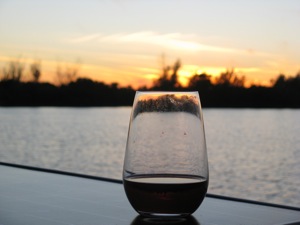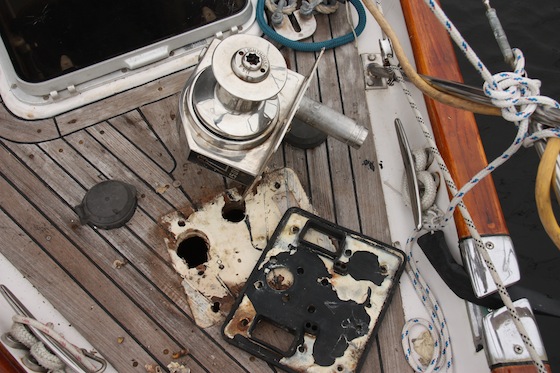Anchored securely off Useppa Island on our way south, we watched in amazement as a large trawler, nice boat, came into the anchorage right at sunset. They motored up behind us and threw over maybe 20 feet of line with nice anchor. The water was 10 feet deep and it looked at least 10 feet from the waterline to their bow. So that’s just about 20 feet. They started backing down … and down … and down … predictably the anchor never set and by the time their stern was almost against the mangroves, they decided to pick up the anchor and try again.
So this time they motored up even closer to our stern and tossed the same anchor over with just a tad more scope. This went on until well after sunset. We’re not sure they ever used much more line, but they finally held well enough that they didn’t drag into us when the wind switched in the middle of the night in an unforecast direction, putting them right in front of us. Good thing I didn’t realize they were right in front of us, I wouldn’t have gotten another wink of sleep!

The moral to the story is THE MOST CRITICAL FACTOR IN ANCHORING SECURELY IS SCOPE! With the 10 feet water depth and another 10 feet from the water to their bow, for a minimal 3:1 scope, they should have had out at least SIXTY FEET of anchor rode.

10 feet water depth, plus 10 feet to the bow (this is the part that’s easy to forget) makes 20 feet total. 3:1 is three times the total — or three times 20 = 60 feet of rode for a minimal anchor scope. Luckily the bottom holding was really good and they finally stayed in one place despite the inadequate scope.
We like to anchor with a minimum of 5:1 scope even with our all chain rode and 30# kellet down – and we really prefer 7:1. And if it’s a wide-open anchorage, we’ve been known to use 10:1 which technically should be reserved for storm anchoring, but sleeping well is worth alot!
Don’t forget to factor in the distance from the water surface to your bow when doing scope calculations.

And another critical tip — when the markers wear off our chain, we often think we have out plenty of scope, only to find when we pick the chain up that we only had about half as much as we thought out. It’s easy to think you have a ton out when there are no markers to let you know how much has gone overboard. So be SURE to mark your anchor chain or rode.
Anyone have other tips on anchor scope?
Please leave a comment and share!
Cheers & safe anchoring! Jan & David














Great post guys, on a great (and often miss-understood) topic! Now around here (Maine’s Penobscot Bay) we have to factor in two other variables – nylon rode and 10-12′ tides! Surprisingly there are also those who use straight nylon, without a chain leader – simple ignorance, I assume, but it makes a huge difference in holding power AND rode lifespan.
Always good for an evenings entertainment as boats come in and try to anchor around you – unless they drag on you later, then it’s not entertaining anymore! 🙂
I usually set the anchor with 3:1 scope and then let it out to at least 5:1 (all chain). I figure that if it’s set good at 3:1, I can sleep soundly with 5:1 or more.
Back in the day when we were commercial fishing, dad had his anchor chain attached to the head of the anchor, and run the chain to the tail, then with light fishing line he whipped the chain to the shaft, this works in a hung anchor situation, cause the line will break and the anchor comes up backward, we could then take a gaff or boat hook and pick up the tail and bring it thru the anchor davit and re do the lite line, we saved many anchors that way, and a stainless sea plow isn’t cheap.